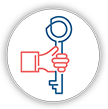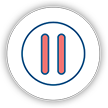
Clinical judgment is a concept that has flooded the literature since at least 2006 when Christine Tanner published the clinical judgment model with four phases of “noticing, interpreting, responding, and reflecting”.
In the last 17 years, nurse educators have wrestled with how to best teach and assess clinical judgment (referred also as clinical reasoning or critical thinking in some sources).
The Problem
In 2005, Del Bueno reported that 35% of new graduate nurses had established clinical judgment skills upon transition to practice. Unfortunately, in 2021, Kavanagh and Sharpnack reported that clinical judgment decreased to 8%. With heightened awareness of these deficits, the NCSBN planned, developed, and implemented the Next Gen NCLEX exam to better assess the cognitive aspects of clinical judgment grounded in the Clinical Judgment Measurement Model (CJMM).
The goal of these efforts is to ensure safe entry-level nurses upon graduation. Nurse educators need to identify effective teaching strategies and assessment methods for clinical judgment to help our students graduate, pass the NCLEX-RN exam, and transition to practice in a safe manner.
One Solution: Reflection
One promising teaching strategy that nurse educators can use to facilitate the development of students’ clinical judgment is reflection.
Reflection can be done through debriefing after a clinical or simulation experience, but it also can be done with a reflection journal using guided questions (Bussard, 2015; Bussard, 2016 Bussard, 2017; Bussard, 2018; Nielsen, et al., 2007). The framework that guides your curriculum can guide the questions in the reflection activities.
For example, our school uses the Tanner Clinical Judgment Model (2006), and the reflection journal is guided by the four phases of the model. There are specific questions under each of the four phases to help the student notice, interpret, respond, and reflect.
The goal of the reflection journal is to help the student reflect, thus helping them develop and progress their clinical judgment. Some examples of reflection questions are:
- “What did you notice from the patient’s history or report that guided your initial nursing care?”
- “Describe your communication with your patient; was it therapeutic or nontherapeutic? Explain”
- “Describe an intervention that you performed and the patient’s response to that intervention. Was this intervention appropriate? Why or why not?”
My Journey
I began using high-fidelity simulation in 2008. At that time there was minimal literature related to best practices, so much of what I did was based on trial and error. In 2010 I began working on a PhD in nursing and focused my attention on simulation.
This led me to learn about the NLN Jeffrey’s Simulation Framework, Tanner’s Clinical Judgment Model, and Lasater’s Clinical Judgment Rubric (LCJR). As I dug into the literature about simulation, I found an article about reflection journals, and this sparked an interest that led to reflecting activities and the current version of my reflection journal.
In the beginning, the reflection journals started out very brief, with minimal questions. After identifying that the questions should be guided and very specific, I began receiving high-level written reflection responses from the students.
We did four reflection journals in one semester, and I noticed that from the first to the fourth reflection journal, there was tremendous growth in their clinical judgment. This became my dissertation focus with the research data that I collected in a qualitative format.
Challenges with Reflection
The struggle with reflection journals is the length of time it takes to grade them. For a student to continue their clinical judgment trajectory, we need to provide them with meaningful feedback.
Some students write 10 pages in their reflection journal and although it’s very time consuming to read the entire journal, it is essential that the faculty member read the journal and provide the feedback so that students can continue to learn.
Many times, it is just me saying “this is fantastic, you’re right on target with your thinking, you prioritized your interventions correctly,” or I might be guiding their thinking in another direction with letting them know that the lab values they interpreted were not correct for the patient and then giving them the rationale for the correct interpretation.
Another struggle is that sometimes students find the journals repetitive, or some students don’t take the journals seriously and therefore provide minimal information.
Therefore, we use the reflection journals as a component of our overall grading of the simulations. We use LCJR to evaluate and assess our student’s simulation scenarios, and the reflection journals are used in the “effective reflecting” category of the rubric. This has helped our students to provide a higher-level reflective thinking pattern.
My hope is that educators will recognize that reflecting is an important teaching strategy that can help develop and progress clinical judgment with prelicensure nursing students. Having a student stop and think about everything they did in the simulation lab or clinical setting will help them make better future decisions.
Your meaningful feedback will provide another avenue for their continued growth. But faculty need to commit to providing this feedback, again, realizing that it is time consuming to read all the journals and provide the feedback.
Next Steps
Here are some suggested next steps to operationalize reflection in your program:
- Develop guided questions in the reflection journal which are based on the clinical judgment framework you use at your school (i.e. Tanner’s Clinical Judgment Model).
- Be prepared to provide meaningful feedback to help your students continue to build their clinical judgment skills. Meaningful feedback should provide students with additional insights and be thought provoking. An example of meaningful feedback could be: “Thank you for this thorough explanation of the patient’s hyperkalemia. You provided great insight into a variety of reasons why this patient’s K+ level was 6.0. I would also like you to consider the patient’s health history of chronic renal failure. What does chronic renal failure do to the K+ level? What medication is this patient receiving that may also impact the K+ level?” Providing feedback on strengths and weaknesses is instrumental to the student.
- Get buy-in from the rest of the faculty to use the same clinical judgment language while in clinical, simulation, theory, skills lab, debriefing, or post-conference. The more often the students hear the clinical judgment terminology the more likely they will connect theory to practice. I suggest faculty development opportunities with experts in the field of clinical judgment to promote faculty support of the clinical judgment model/terminology. Our school hosted Kathie Lasater, Linda Caputi, and Keith Rischer as experts in the field of clinical judgment!
- What type of framework do you use for teaching clinical judgment?
- How does this framework connect learning between the classroom, clinical, and laboratory settings?
- What type of strategies do you use to incorporate the framework throughout the curriculum?
- What type of reflection activities do you do and how often?
Closing Thoughts
Let’s reflect on reflection for a moment…reflection, reflection, reflection, let me say it again, reflection! Reflection is instrumental to developing clinical judgment.
Reflecting helps students develop clinical judgment and in fact, Christine Tanner said reflection is the key to developing clinical judgment.
My challenge for educators is to identify strategies to help students reflect and commit to providing students with meaningful feedback within those activities.
Recommended Resources
Besides Dr. Bussard’s references and her articles on the use of reflection, I highly recommend that every nurse educator learn more about the innovative work of the International Consortium for Outcomes of Nursing Education (ICONEd) a group comprised of nurse educators committed to closing the academic-practice gap.
References
- Bussard, M. E. (2017). Postdebriefing activities following simulation. Teaching and Learning in Nursing, 12(3), 220–222. http://dx.doi.org/10.1016/j.teln.2017.03.010
- Bussard, M. (2016). Self-reflection of video recorded high-fidelity simulations and development of clinical judgment. Journal of Nursing Education,55(9), 522-527.
- http://doi:10.3928/01484834-20160816-06
- Bussard, M. (2015). Evaluation of clinical judgment within Reflective journals of Pre-licensure nursing student. Journal of Nursing Education, 54(8), 451-454.
- Bussard, M. (2015). Clinical judgment in reflective journals of pre-licensure nursing students. Journal of Nursing Education, 54(1), 36-40.
- Bussard, M. (2013). Interpretive description of clinical judgment within reflective journals of nursing students participating in high-fidelity simulation (Doctoral dissertation). Retrieved from ProQuest. (3578583).
- Del Bueno, D. (2005). A crisis in critical thinking. Nursing Education Perspectives, 26(5), 278-282.
- Kavanagh, J. M., & Sharpnack, P. A. (2021). Crisis in competency: A defining moment in nursing education. The Online Journal of Issues in Nursing, 26(1), Manuscript 2.
- Nielsen, A., Stragnell, S., & Jester, P. (2007). Guide for reflection using the clinical judgment model. Journal of Nursing Education, 46(11), 513-516. Retrieved from
- www.slackjournals.com/jne
- Tanner, C. (2006). Thinking like a nurse: A research-based model of clinical judgment in nursing. Journal of Nursing Education, 45(6), 204-211.
Dr. Shelly Bussard, PhD, RN, ACNS-BC, CNE is the Director of the Bowling Green State University School of Nursing and Associate Professor. She has been a Reregistered nurse since 1996 and has background in adult medical/surgical intensive care.
She has been an educator since 2004 working with prelicensure nursing students. Her research is mainly focused on teaching strategies and the development of clinical judgment. Dr. Bussard is an Adult Clinical Nurse Specialist and Certified Nurse Educator.
The Ultimate Solution to Develop Clinical Judgment Skills
KeithRN’s Think Like a Nurse Membership
Access exclusive active learning resources for faculty and students, including KeithRN Case Studies, making it your go-to resource.
Sign up to receive a free KeithRN NextGen Case Study!
Develop clinical judgment skills with this innovative new case study on asthma to prepare your students for NextGen NCLEX and practice!
The Ultimate Solution to Develop Clinical Judgment Skills
KeithRN’s Think Like a Nurse Membership
Access exclusive active learning resources for faculty and students, including KeithRN Case Studies, making it your go-to resource.





